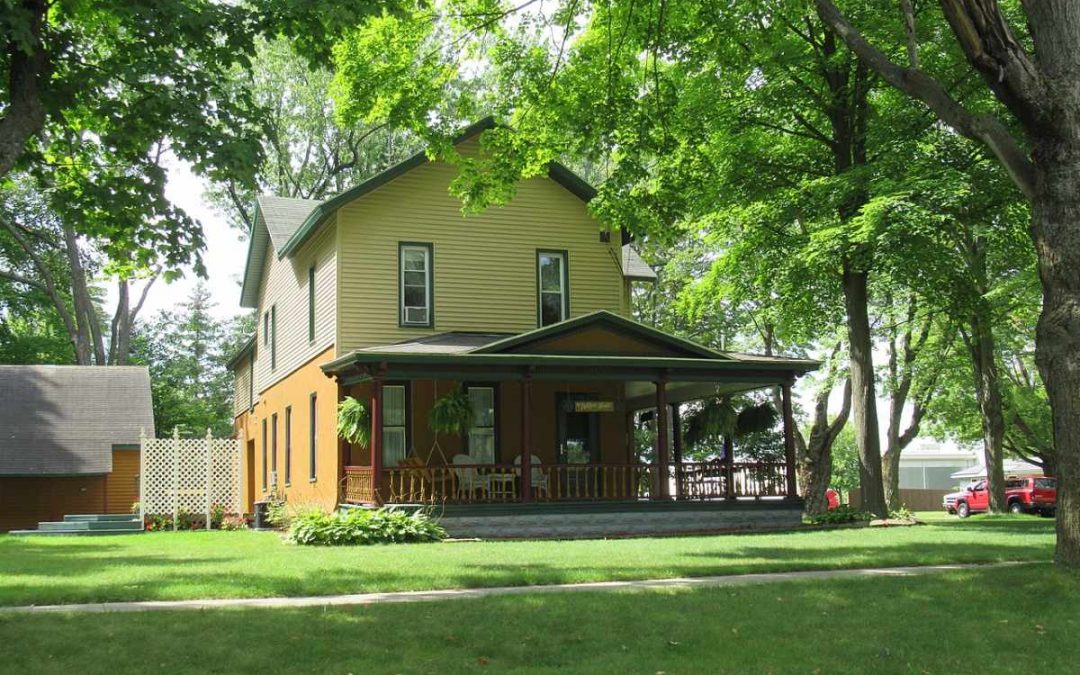Despite large seasonal changes in temperature, you can still enjoy games, barbecues, and other outdoor activities in your Michigan lawn. But if your outdoor living space looks dull and lifeless, it won’t feel all that inviting. Avoid that scenario and get started on a new landscaping project with some of the best native trees and shrubs for Michigan yards.
In this article, we will cover:
- Native Trees and Shrubs for Michigan Yards
- How to Choose Native Trees and Shrubs for Your Michigan Landscape
- FAQ About Michigan Native Trees and Shrubs
- Where to Find Michigan Native Trees and Shrubs
Native Trees and Shrubs for Michigan Yards
The Wolverine State lies in USDA plant hardiness zones 3 to 6. All the plants in the upcoming section are a great fit for these zones, as well as Michigan’s year-round climate. Choosing the right plants for your area will ensure a healthy growth with minimal maintenance. Michigan native plants can boost the local ecosystem and serve as a valuable food source for the local wildlife habitat.
1. Basswood (Tilia americana)
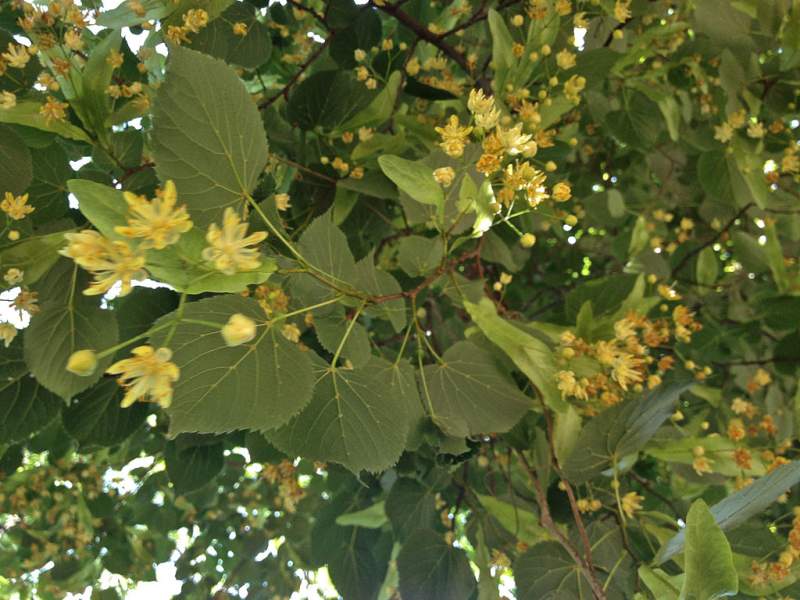
Photo Credit: Fritzflohrreynolds / Wikimedia Commons / CC BY-SA 3.0
Basswood is a large, deciduous shrub adorned with an ovate-rounded crown. It boasts large, dark green leaves that turn yellow-green in the fall. Creamy-yellow, fragrant flowers appear in early summer. They are highly attractive to bees and contribute to the production of honey. The blossoms are followed by hard-shelled nutlets that ripen in late summer. Basswood can be used as a shade or street tree.
Plant type: Tree
USDA hardiness zones: 2 to 8
Sun: Full sun, partial shade
Soil: Chalk, clay, loam, sand
Duration: Perennial
Fragrance: Sweetly scented
Bloom time: April – July
Water needs: Low, average
Mature height: 50 to 80 feet
Maintenance: Low
2. Red Maple (Acer rubrum)
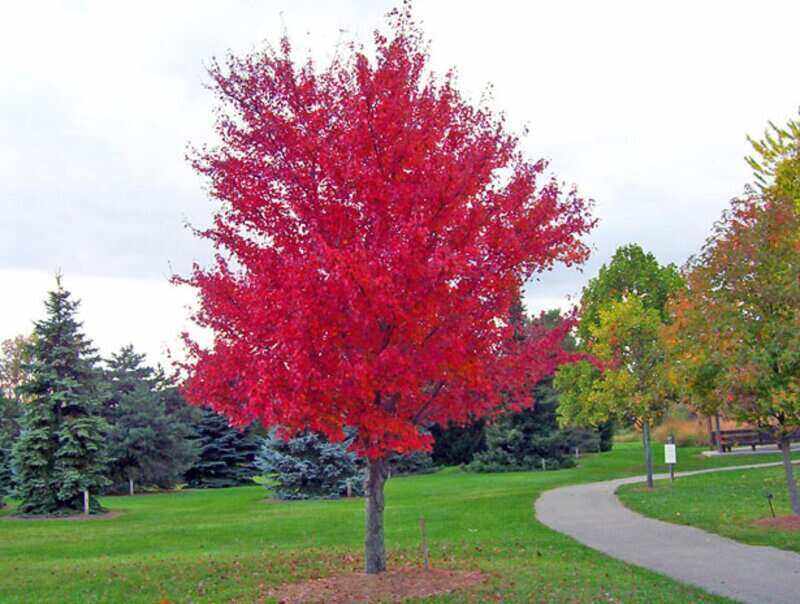
Photo Credit: Public Domain Pictures
Red maple is a fast-growing, deciduous tree that can provide your Michigan lawn with a lovely fall color. Tiny red flowers appear in early spring, followed by red fruits. For those seeking a low-maintenance yard, red maple trees require very little pruning.
Thanks to its smooth gray bark, this native perennial is just as attractive during the winter. Red maple is an excellent choice as specimen planting for lawns and streets.
Plant type: Tree
USDA Hardiness Zone: 3 to 9
Sun: Full sun, partial shade
Soil: Chalk, clay, loam, sand
Duration: Perennial
Fragrance: Sweet cherry or almond flower scent
Bloom time: March – April
Water needs: Average
Mature height: 40 to 70 feet
Potential hazards: Toxic to horses
3. Northern Bush Honeysuckle (Diervilla lonicera)
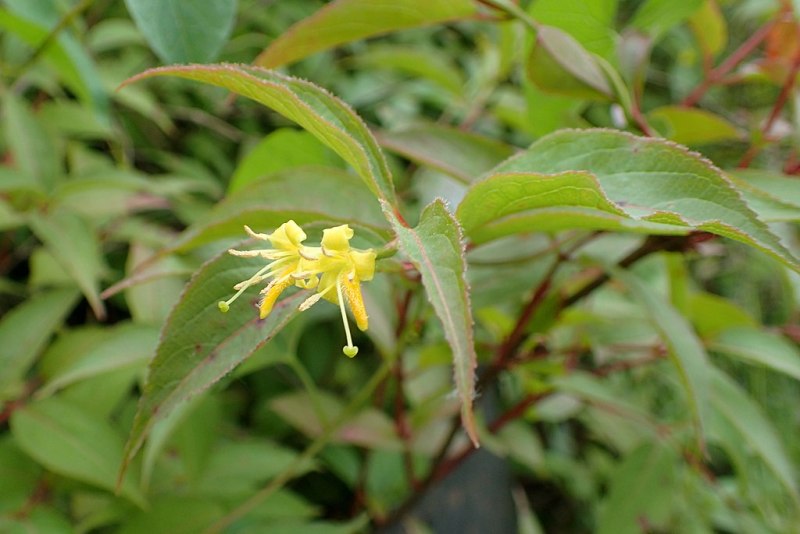
Photo Credit: Krzysztof Ziarnek, Kenraiz / Wikimedia Commons / CC BY-SA 4.0
This densely branched, deciduous shrub thrives in a wide range of light and soil conditions. It forms an attractive, colorful mound of lance-shaped, shiny leaves. A profusion of yellow to orange flowers appear in the lower leaf axils and at the branch tips. The blossoms are magnets for bees, hummingbirds, and butterflies. Over time, this native shrub forms broad thickets that provide shelter for ground-nesting birds.
Northern bush honeysuckle becomes drought-tolerant once established. It is perfect for shrub borders, woodland or butterfly gardens.
Plant type: Shrub
USDA Hardiness zone: 3 to 7
Sun: Full sun to partial shade
Bloom time: Summer
Water needs: Low, average
Soil: Not particular; grows in range of soil types and withstands dry and seasonally flooded soils
Duration: Perennial
Mature height: 2 to 4 feet
Maintenance: Low, prune in late winter
4. White Oak (Quercus alba)
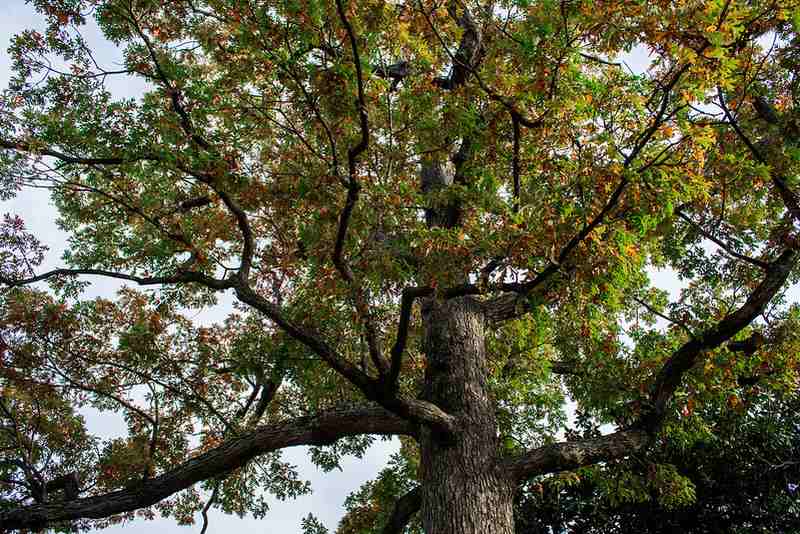
Photo Credit: Tim Evanson / Flickr / CC BY-SA 2.0
White oak is a large, deciduous perennial that’s another great option for a shade or lawn tree. Pink leaves emerge in spring, followed by yellow-green catkins. White oak will eventually give way to brown, oval acorns that are a valuable source of food for birds and small mammals.
Once established, white oak trees will adopt drought-resistant and salt-tolerant qualities. If your outdoor living space is large enough, this native perennial can be a valuable specimen tree.
Plant type: Tree
USDA Hardiness Zone: 3 to 9
Sun: Full sun or partial sun
Soil: Moist but well-drained clay, loam, sandy soils
Duration: Perennial
Fragrance: Vanilla
Bloom time: April to May
Water needs: Low
Mature height: 100 feet
Potential hazards: Toxic to horses
Maintenance: Low
5. Red Elderberry (Sambucus racemosa)
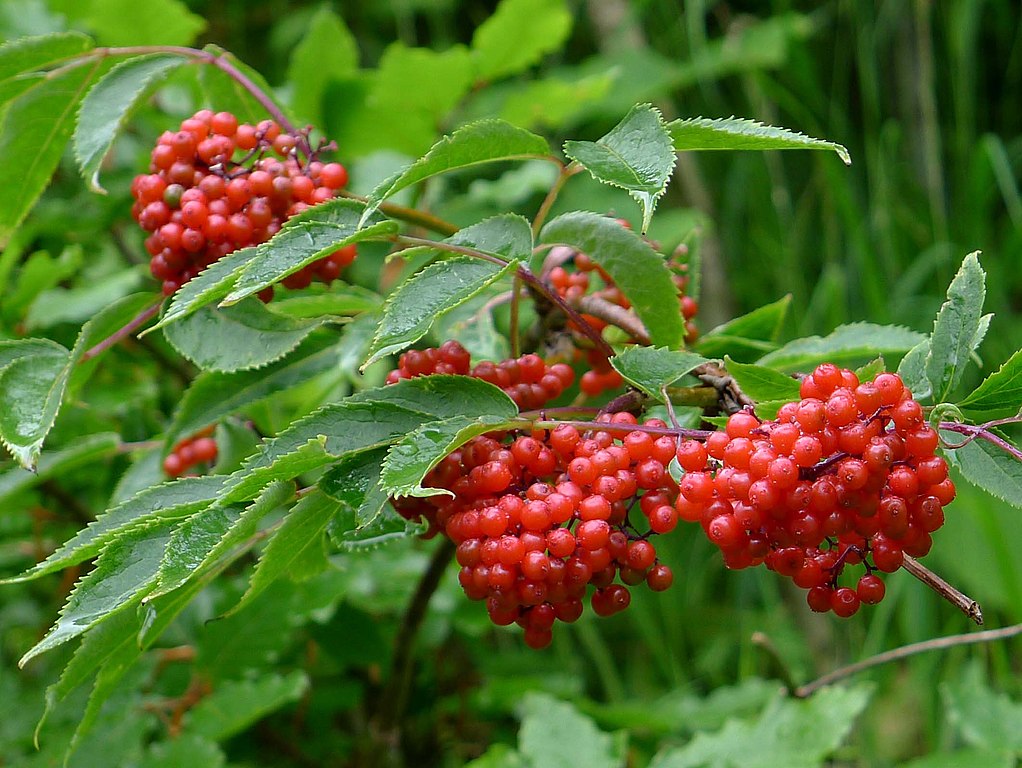
Photo Credit: gailhampshire from Cradley, Malvern, U.K / Wikimedia Commons / CC BY 2.0
Red elderberry is a deciduous, suckering shrub that performs best in humus-rich, well-drained soils. Abundant clusters of white flowers appear near the branch in late spring to early summer, which attract butterflies and hummingbirds. In the fall, the blossoms give way to berries that are devoured by birds. This easy-to-grow shrub fits beautifully in mixed borders, or can be used as a specimen plant.
Plant type: Shrub
USDA Hardiness Zone: 3 to 7
Sun: Full sun or partial shade
Soil: Moist and well-drained
Duration: Perennial
Fragrance: Flowers have floral scent; leaves have unpleasant, stinky odor when crushed
Bloom time: Spring and summer
Water needs: Medium; water in the absence of rain
Mature height: 3 to 9 feet
Potential hazards: Seeds are poisonous; raw berries are toxic
Maintenance: Medium; prune to contain spread
6. Common Buttonbush (Cephalanthus occidentalis)
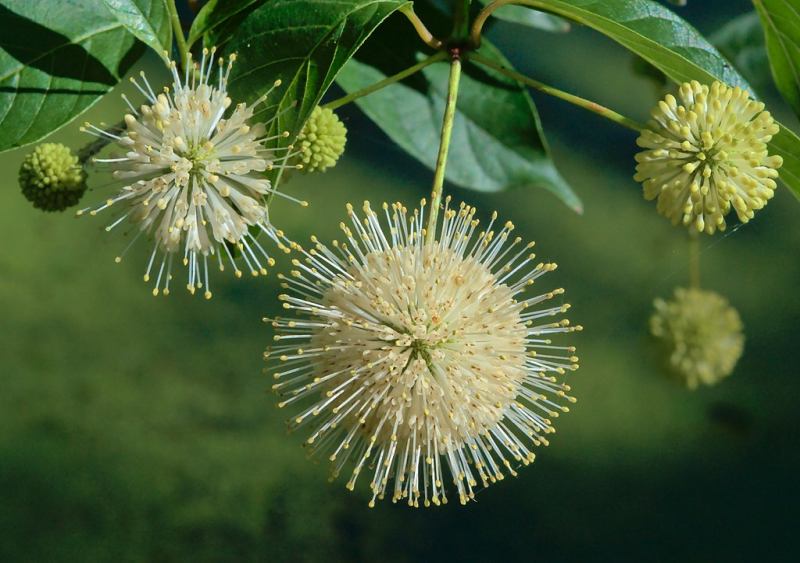
Photo Credit: The Cosmonaut / Wikimedia Commons / CC BY-SA 4.0
Common buttonbush is a multi-stemmed, ornamental shrub that is suited for wet soils. This native perennial has a foliage of oval, glossy bright green leaves. It boasts long-lasting, spherical flower heads in early summer to early fall. Each flower head is packed with creamy-white flowers that are very attractive to hummingbirds, butterflies, and other pollinators. Common buttonbush fits perfectly in cottage, bog, or rain gardens.
Plant type: Shrub
USDA Hardiness Zone: 5 to 11
Sun: Full sun, partial shade
Soil: Loam, sand
Duration: Perennial
Fragrance: Dried flowers and leaves smell like freshly-mown grass
Bloom time: June – September
Water needs: Average, high
Mature height: 5 to 12 feet
Potential hazards: Poisonous to humans, pets, and other animals if ingested.
Maintenance: Low
7. Nannyberry (Viburnum lentago)
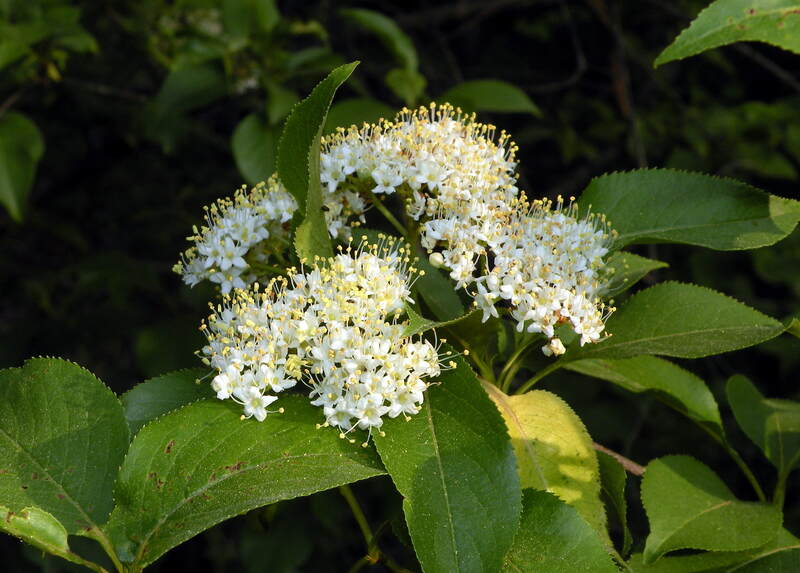
Photo Credit: Doug McGrady / Flickr / CC BY 2.0
Nannyberry is a native perennial that can serve as a large, suckering shrub or a multi-stemmed small tree. Masses of creamy-white flower clusters emerge in spring, elegantly held above the handsome foliage of dark green leaves. The flowers are loved by bees, butterflies, and other pollinators. The blooms give way to bluish-black berries with bright red stalks in fall.
These fruits are quite tasty, and can be eaten fresh from the shrub or used to make jams. This durable, pest-free shrub can be used in shrub borders or as a specimen plant.
Plant type: Shrub or small tree
USDA Hardiness zones: 2 to 8
Sun: Full sun to partial shade
Soil: Clay, loam, sand, moist, well-drained soil
Duration: Perennial
Fragrance: Berries smell like wet sheep’s wool when overripe
Bloom time: April – June
Water needs: Medium
Mature height: 10 to 20 feet
Maintenance: Low
8. Serviceberry (Amelanchier alnifolia)
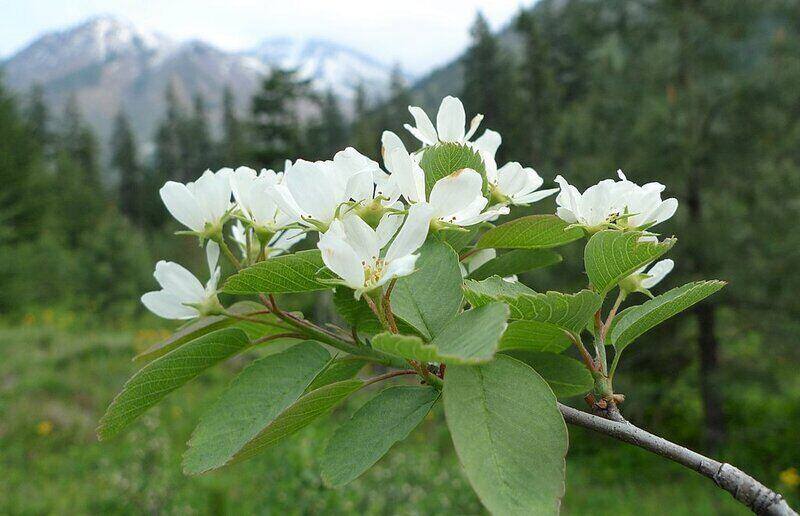
Photo Credit: Thayne Tuason / Wikimedia Commons / CC BY-SA 4.0
Serviceberry is a drought-tolerant, deciduous perennial that can be used as an attractive, ornamental shrub. In addition to aesthetics, serviceberry plants can be used for erosion control.
The foliage of light-green oval leaves turns to shades of orange and red in the fall. In mid-spring, compact clusters or white flowers emerge just before the leaves. They are followed by sweet, blue-colored berries in early summer. Both birds and humans share their love of these berries.
Plant type: Shrub or small tree
USDA Hardiness Zone: 4 to 9
Sun: Full sun or partial shade
Soil: Loamy or sandy; well-drained
Duration: Perennial
Fragrance: Lightly scented
Bloom time: Spring and summer
Water needs: Low
Mature height: 3 to 16 feet
Maintenance: Low
9. Flowering Dogwood (Cornus florida)
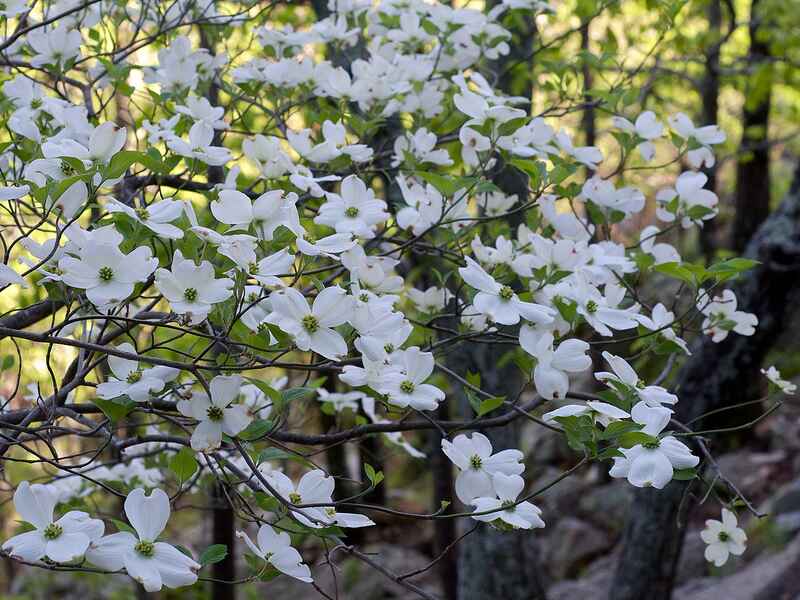
Photo Credit: Eric Hunt / Wikimedia Commons / CC BY-SA 4.0
Flowering dogwood is another native perennial that can be used as a large shrub or a small, deciduous tree. It is a popular landscape tree that’s regarded by many gardeners as one of the best flowering trees. Its blossoms give way to rounded, glistening orange-red fruits in the summer. It is perfect for a low-maintenance landscape, as it does not require regular pruning.
Plant type: Tree
USDA Hardiness Zone: 5 to 9
Sun: Grows best in part shade but can tolerate full sun
Soil: organically rich, moist, acidic soil
Duration: Perennial
Fragrance: Slightly fragrant
Bloom time: March – June
Water needs: Medium
Mature height: 15 to 30 feet, sometimes reaching up to 40 feet
Maintenance: Low
How to Choose Native Trees and Shrubs for Your Michigan Yard
The plant hardiness zone isn’t the only factor that determines the plants ability to thrive in Michigan. If your lawn is too shady, do not go for plants that require full sun to grow, or ones that will bring even more shade to your backyard. You’re trying to create an inviting outdoor living space, not a place for Dracula to rest in. Homeowners should also consider the different soil types, availability of water, and other significant factors that help in establishing Michigan native plants.
FAQ About Michigan Native Trees and Shrubs
There are plenty of trees that thrive in Michigan’s climate and hardiness zones. Shrubs are equally important in this current article, so we had to share the spotlight.
Sugar maple, or acer saccharum, is one of the most common trees found in Michigan’s forests. The fruit of the tree is called a samara, it contains seeds that are adored by squirrels and other small mammals.
As for the state tree, it’s the eastern white pine (pinus strobus). It was officially made Michigan’s tree on March 4, 1955. Not only is it commonly found across the state, but it symbolizes Michigan’s rich logging history.
Nothing would make us happier than to provide you with as many Michigan native plants as possible! But don’t worry, we will keep the list short and interesting enough.
Some perennials may only thrive in southern parts of the state, some just the north, which is why this article focused on plants that can grow in almost every part of Michigan. In addition to the abovementioned trees and shrubs, here are some species for you to consider:
• Red hickory (Carya ovalis)
• Poke milkweed (Asclepias exaltata)
• Common ninebark (Physocarpus opulifolius)
• Gray dogwood (Cornus racemosa)
• Snowberry (Symphoricarpos)
• Black gum tree (Nyssa sylvatica)
• Northern red oak (Quercus rubra)
Every state in North America has to deal with invasive species, whether they are trees, shrubs, wildflowers, or even insects. Michigan is no different, and there are plenty of invasive trees and shrubs that can disrupt the growth and survival of native species.
According to the Michigan State University Extension, here are some of the worst invasive plants to look out for:
• Black alder (Alnus glutinosa)
• Black locust (Robinia pseudoacacia)
• Norway maple (Acer platanoides)
• Autumn olive (Elaeagnus umbellata)
• Black jetbead (Rhodotypos scandens)
• Amur honeysuckle (Lonicera maackii)
Where to Find Michigan Native Trees and Shrubs
If you regularly enjoy hiking or exploring the endless wonders of mother nature, then odds are you’ve come across native trees or shrubs. Plants that grow naturally in Michigan can be found in forests, national parks, or even wetlands. You can also find plenty of native shrubs and trees at local nurseries or garden centers.
But why stop at native plants? Make it a complete project and revamp your outdoors with low-maintenance landscaping ideas for Michigan.
Despite planting low-maintenance trees and shrubs, your lawn may still require the occasional mowing or edging. Hire a local lawn care professional and cross lawn chores off your to-do list. You can find trusted professionals in Grand Rapids, Detroit, Grandville, and many other cities across the state.
Main Photo Credit: William Henry Wilson House / Notorious4life (talk) (Uploads) / Wikimedia Commons / CC0

